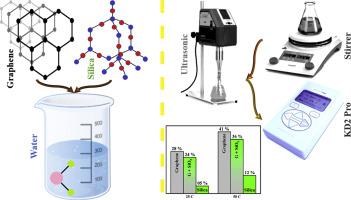当前位置:
X-MOL 学术
›
Int. Commun. Heat Mass Transf.
›
论文详情
Our official English website, www.x-mol.net, welcomes your feedback! (Note: you will need to create a separate account there.)
Improving the thermal conductivity of water by adding mono & hybrid nano-additives containing graphene and silica: A comparative experimental study
International Communications in Heat and Mass Transfer ( IF 7 ) Pub Date : 2020-07-01 , DOI: 10.1016/j.icheatmasstransfer.2020.104648 Iman Kazemi , Mohammad Sefid , Masoud Afrand
International Communications in Heat and Mass Transfer ( IF 7 ) Pub Date : 2020-07-01 , DOI: 10.1016/j.icheatmasstransfer.2020.104648 Iman Kazemi , Mohammad Sefid , Masoud Afrand

|
Abstract Effect of addition and hybridization of Graphene (G) and Silica (SiO2) nanoparticles on thermal conductivity of water, was experimentally studied. Initially, XRD, FTIR and FESEM tests were performed to specify phase and structural analysis and microstructural-observation of nano-materials. After that, nano-materials were dispersed and homogenized in distilled water by magnetic stirrer and ultrasonic vibrator, using the two-step method. The stability of graphene and silica nanoparticles in the base fluid at different pH values was examined. Thermal conductivity of three types of nanofluids, G/Water, SiO2/Water and G-SiO2/Water, at different volume fractions (φ) of 0.05–1% and temperature (T) range of 25-50 °C was measured. For predicting the thermal conductivity of G-SiO2/water hybrid-nanofluid, a two-variable correlation with R-Squared = 0.99 was extracted from experimental data by curve fitting method. The most and the least thermal conductivity enhancement attributed to G/water and SiO2/water mono-nanofluids respectively; while thermal conductivity enhancement between these two values and closer to the greater value associated with G-SiO2/water hybrid-nanofluid. By comparing the thermal conductivity results of the three present types of nanofluids, G-SiO2/Water hybrid-nanofluid would be a good choice as a high thermal and cost-effective nanofluid for thermal equipment.
中文翻译:

通过添加含有石墨烯和二氧化硅的单一和混合纳米添加剂来提高水的热导率:对比实验研究
摘要 实验研究了石墨烯(G)和二氧化硅(SiO2)纳米颗粒的添加和杂化对水热导率的影响。最初,进行 XRD、FTIR 和 FESEM 测试以指定纳米材料的相和结构分析以及微观结构观察。之后,通过磁力搅拌器和超声波振动器,使用两步法将纳米材料在蒸馏水中分散和均质。检查了基液中石墨烯和二氧化硅纳米粒子在不同 pH 值下的稳定性。在 0.05-1% 的不同体积分数 (φ) 和 25-50 °C 的温度 (T) 范围内测量了三种类型的纳米流体 G/水、SiO2/水和 G-SiO2/水的热导率。用于预测 G-SiO2/水混合纳米流体的热导率,通过曲线拟合方法从实验数据中提取了与 R-Squared = 0.99 的二变量相关性。最大和最小的热导率增强分别归因于 G/水和 SiO2/水单纳米流体;而这两个值之间的热导率增强并且更接近与 G-SiO2/水混合纳米流体相关的较大值。通过比较目前三种纳米流体的热导率结果,G-SiO2/水混合纳米流体作为热设备的高热和成本效益纳米流体将是一个不错的选择。而这两个值之间的热导率增强并且更接近与 G-SiO2/水混合纳米流体相关的较大值。通过比较目前三种纳米流体的热导率结果,G-SiO2/水混合纳米流体作为热设备的高热和成本效益纳米流体将是一个不错的选择。而这两个值之间的热导率增强并且更接近与 G-SiO2/水混合纳米流体相关的较大值。通过比较目前三种纳米流体的热导率结果,G-SiO2/水混合纳米流体作为热设备的高热和成本效益纳米流体将是一个不错的选择。
更新日期:2020-07-01
中文翻译:

通过添加含有石墨烯和二氧化硅的单一和混合纳米添加剂来提高水的热导率:对比实验研究
摘要 实验研究了石墨烯(G)和二氧化硅(SiO2)纳米颗粒的添加和杂化对水热导率的影响。最初,进行 XRD、FTIR 和 FESEM 测试以指定纳米材料的相和结构分析以及微观结构观察。之后,通过磁力搅拌器和超声波振动器,使用两步法将纳米材料在蒸馏水中分散和均质。检查了基液中石墨烯和二氧化硅纳米粒子在不同 pH 值下的稳定性。在 0.05-1% 的不同体积分数 (φ) 和 25-50 °C 的温度 (T) 范围内测量了三种类型的纳米流体 G/水、SiO2/水和 G-SiO2/水的热导率。用于预测 G-SiO2/水混合纳米流体的热导率,通过曲线拟合方法从实验数据中提取了与 R-Squared = 0.99 的二变量相关性。最大和最小的热导率增强分别归因于 G/水和 SiO2/水单纳米流体;而这两个值之间的热导率增强并且更接近与 G-SiO2/水混合纳米流体相关的较大值。通过比较目前三种纳米流体的热导率结果,G-SiO2/水混合纳米流体作为热设备的高热和成本效益纳米流体将是一个不错的选择。而这两个值之间的热导率增强并且更接近与 G-SiO2/水混合纳米流体相关的较大值。通过比较目前三种纳米流体的热导率结果,G-SiO2/水混合纳米流体作为热设备的高热和成本效益纳米流体将是一个不错的选择。而这两个值之间的热导率增强并且更接近与 G-SiO2/水混合纳米流体相关的较大值。通过比较目前三种纳米流体的热导率结果,G-SiO2/水混合纳米流体作为热设备的高热和成本效益纳米流体将是一个不错的选择。



























 京公网安备 11010802027423号
京公网安备 11010802027423号